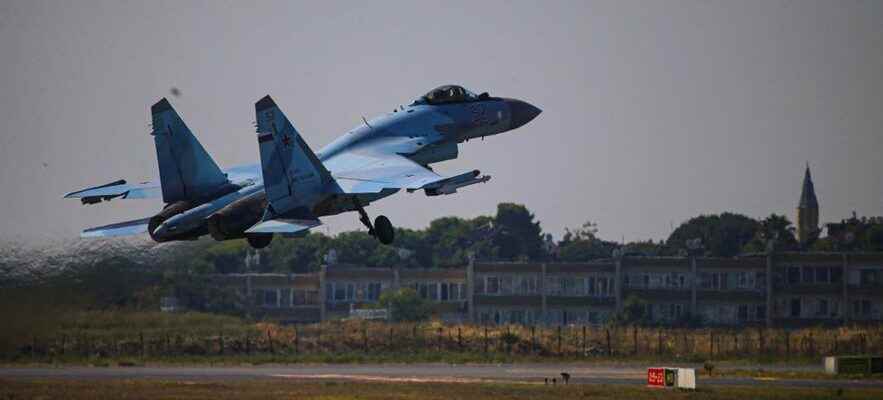On the Caspian Sea, the scene has become almost habitual. Since the end of the summer, Iranian ships have been parading towards the Russian ports of Astrakhan and Makhachkala. On board are the fearsome Shahed 136 kamikaze drones, which the Islamic Republic is exporting en masse to Russia to support its war effort in Ukraine. First appearing in Ukrainian skies in September, they now crash into the four corners of the country every week. For a Russia whose stock of missiles is beginning to run out after ten months of conflict, this ammunition is decisive.
With these drones, Putin is pursuing his strategy of terror aimed at destroying Ukrainian energy infrastructure, at a time when temperatures are often negative. Following a new wave of attacks launched Monday, December 19, power cuts were reported in kyiv and in a dozen regions. The phenomenon is of such magnitude that it prompted Washington to sound the alarm on December 9. “Iran has become Russia’s main military support, alerted the deputy spokesman for American diplomacy, Vedant Patel. And to add that, since August, this country “has transferred several hundred drones to Russia. “According to the Ukrainian secret service, Moscow ordered at least 2,400.
Exchange of good practices
“The Iranian equipment is not the most technologically advanced, but it remains relatively reliable and has the advantage of being able to be produced in quantity, quickly, and inexpensively, points out Mathieu Boulègue, Chatham House associate researcher, and specialist in Eurasia The fact that Russia is turning towards Iran is, however, a clear sign of its isolation on the international scene: Moscow no longer has many friends, and those that it does have are not very recommendable states. ” This does not prevent the arrivals from continuing. “A new batch” of killer drones have thus been delivered in recent days, Ukrainian intelligence said on December 18.
The war in Ukraine served as an accelerator for the political and strategic rapprochement between the two countries. “The feeling of the Iranian leaders is that we have entered a bipolarization of the world and that we must now choose sides between the United States on one side, and Russia and China on the other” , notes Thierry Coville, researcher at the Institute of International and Strategic Relations and author of Iran, a power in motion (Eyrolles, June 2022).
A Russian Su-35 aircraft performing demonstration flights at the TEKNOFEST show in Istanbul on September 18, 2019.
© / Anadolu Agency via AFP
The support of the Islamic Republic is however not only motivated by a position of principle on the world stage. In exchange for its kamikaze drones, Tehran is particularly eyeing the Russian air force, in order to modernize its aging fleet. According to Washington, Iranian pilots have already begun to train in Russia on Su-35 fighter planes, some of which could be delivered to it as early as “next year”. “Iran has been facing a structural weakness in its aviation and anti-aircraft defenses for years, abounds Thierry Coville. The Iranians hope to be able to remedy this problem by strengthening their military cooperation with Russia.”
Extended cooperation
Well aware of the growing weight of Tehran in the conflict in Ukraine, the European Union and the United States sanctioned in early December several companies involved in the delivery of Iranian drones to Moscow. Then, on the 16th, the Twenty-Seven banned the export of drone engines intended for Russia, as well as “all third countries” – including Iran – which could supply them. But at a time when Iranian power is facing an unprecedented protest movement within its borders, its cooperation with Moscow may not stop there. “We are concerned that Moscow will advise Tehran on how best to end the protests, drawing on Russia’s vast experience in suppressing protests,” the White House spokeswoman said on October 26. , Karine Jean-Pierre.
In response to growing Western concerns, Tehran said on December 18 that it needed “nobody’s permission” to develop its relations with Moscow. “Cooperation between Iran and Russia in various fields, including defense cooperation, is developing within the framework of common interests,” said Foreign Ministry spokesman Nasser Kanani. According to Washington, the two countries would soon consider setting up a joint production unit for drones in Russia. At the same time, Iran would also consider selling “hundreds” of ballistic missiles to Moscow.
How far will their rapprochement go? “It is possible that military cooperation will deepen and lead to other agreements, such as the sale to Iran of Russian anti-aircraft systems S-400, estimates Katarzyna Zysk, professor at the Norwegian Institute of These advanced systems would strengthen the Iranian regime and make the situation in the Middle East all the more difficult for countries like the United States or Israel. Not enough to reassure Westerners.
